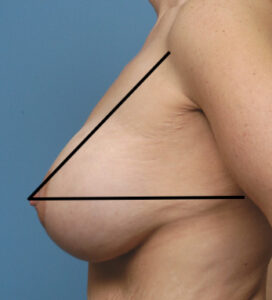Breast implants are the second most common body contouring procedures behind liposuction and the most frequently performed implant placed in the body. As a result there is tremendous familiarity with breast augmentation surgery and its potential aesthetic effects. There is little question that the primary effect of breast implants is to make the breasts bigger. But the one potential effect that is often misunderstood is the effects such implants can have on a sagging breast.
It is often assumed that the added volume of a breast implant can lift a sagging breast and this is true…up to a certain amount of sag. The rule of thumb is that as long as the nipple is above the inframammary fold an implant will lift the nipple higher. The nipple can even be as low as the actual inframammry fold and it will still be lifted. The position of the nipple on the mound is a reflection of how much loose breast skin exists. Thus it can also be seen that with enough implant volume even substantial loose breast skin can be filled and the nipple subsequently lifted. This can be best appreciated geometrically using a triangulation method in profile. One can see that as long as the lower limb of the triangle is horizontal, or nearly so, an implant will cause a breast lifting effect by volumetric expansion.




Dr. Barry Eppley
Indianapolis, Indiana








